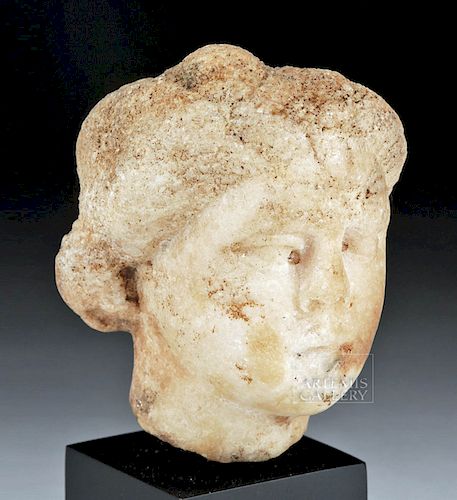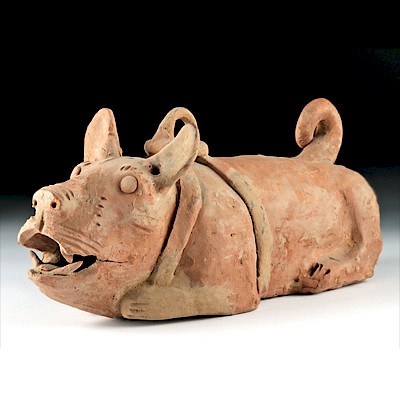Roman Marble Female Head - Muse
Lot 24a
About Seller
Artemis Fine Arts
686 S Taylor Ave, Ste 106
Louisville, CO 80027
United States
Selling antiquities, ancient and ethnographic art online since 1993, Artemis Gallery specializes in Classical Antiquities (Egyptian, Greek, Roman, Near Eastern), Asian, Pre-Columbian, African / Tribal / Oceanographic art. Our extensive inventory includes pottery, stone, metal, wood, glass and textil...Read more
Estimate:
$1,200 - $1,800
Absentee vs Live bid
Two ways to bid:
- Leave a max absentee bid and the platform will bid on your behalf up to your maximum bid during the live auction.
- Bid live during the auction and your bids will be submitted real-time to the auctioneer.
Bid Increments
| Price | Bid Increment |
|---|---|
| $0 | $25 |
| $300 | $50 |
| $1,000 | $100 |
| $2,000 | $250 |
| $5,000 | $500 |
| $10,000 | $1,000 |
| $20,000 | $2,500 |
| $50,000 | $5,000 |
| $100,000 | $10,000 |
| $200,000 | $20,000 |
About Auction
By Artemis Fine Arts
Sep 13, 2018
Set Reminder
2018-09-13 10:00:00
2018-09-13 10:00:00
America/New_York
Bidsquare
Bidsquare : Ancient | Asian | Ethnographic - Fall Variety
https://www.bidsquare.com/auctions/artemis-gallery/ancient-asian-ethnographic---fall-variety-3432
Travel the world and back in time... Antiquities from Egypt, Greece, Italy and the Near East, Asian, Pre-Columbian, African / Tribal / Oceanic, Native American, Spanish Colonial, Russian Icons, Fine Art, much more! Artemis Fine Arts info@artemisgallery.com
Travel the world and back in time... Antiquities from Egypt, Greece, Italy and the Near East, Asian, Pre-Columbian, African / Tribal / Oceanic, Native American, Spanish Colonial, Russian Icons, Fine Art, much more! Artemis Fine Arts info@artemisgallery.com
- Lot Description
Roman, Imperial Period, ca. 1st to 2nd century CE. A lovely carved marble head of a female, perhaps representing a Muse, with heavily lidded almond-shaped eyes, a straight nose, fleshy cheeks, and a closed mouth with full, heart-shaped lips. Her hairdo, with meticulously incised locks, is pulled back from her face, tied at the nape of her neck, and held in place by a fillet. Size: 2.625" H (6.7 cm); 4.25" H (10.8 cm) on included custom stand.
Sources of inspiration to poets, Muses were goddesses of music, song, and dance. In classical sculpture and vase painting, the Muses (Musai) were depicted as graceful young woman with various attributes such as musical instruments. Muses were also revered as goddesses of knowledge who possessed remarkable memory. In time, the muses were given specific names and assigned particular artistic realms: Kalliope (Calliope) for epic poetry; Kleio (Clio) for history; Ourania (Urania) for astronomy; Thaleia (Thalia) for comedy; Melpomene for tragedy; Polymnia (Polyhymnia) for religious hymns; Erato for erotic poetry; Euterpe for lyric poetry; and Terpsikhore (Terpsichore) for choral song and dance.
Provenance: private East Coast, USA collection, ex Charles Ede; ex-Gustave Mustaki, Alexandria, Egypt: exported from Egypt to the UK under licence 1949, thence by descent
All items legal to buy/sell under U.S. Statute covering cultural patrimony Code 2600, CHAPTER 14, and are guaranteed to be as described or your money back.
A Certificate of Authenticity will accompany all winning bids.
We ship worldwide and handle all shipping in-house for your convenience.
#132512A section from a larger piece with old losses/chips to the coiffure, forehead, and neck. Normal surface wear and staining commensurate with age.Condition
- Shipping Info
-
All shipping is handled in-house for your convenience. Your invoice from Artemis Gallery will include shipping calculation instructions. If in doubt, please inquire BEFORE bidding for estimated shipping costs for individual items.
-
- Buyer's Premium



 EUR
EUR CAD
CAD AUD
AUD GBP
GBP MXN
MXN HKD
HKD CNY
CNY MYR
MYR SEK
SEK SGD
SGD CHF
CHF THB
THB
















